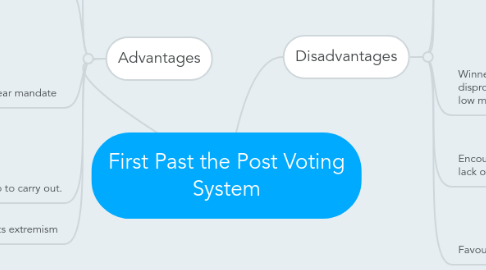
1. Advantages
1.1. Close link with constituents
1.1.1. MPs have regular meeting.
1.1.2. Each constituency is about 70,000 people
1.2. Simple to Understand
1.2.1. Voters only select one box
1.2.2. Due the simplicity reduces the amount of spoilt ballots.
1.3. Usually gives the winner a clear mandate
1.3.1. Since WWII there have only been two occasions where a clear majority has not occured.
1.3.2. 1974 and 2010 there were results where no one party had a clear majority.
1.3.3. This gives strong and stable government.
1.4. Due to the simplicity it is cheap to carry out.
1.5. Limits extremism
1.5.1. Difficult for extremist parties such as BNP to gain seats.
2. Disadvantages
2.1. Does not produce a proportional outcome.
2.1.1. In 2005 Labour obtained 35% of the popular vote but obtained 55% of the seats / Lib Dems 18% of popular vote but 9% of seats.
2.2. Can lead to wasted votes
2.2.1. In the 2015 general election it is predicted that less than 100 seats are marginal and will change hands.
2.2.2. Once a candidate gets the majority of votes all other votes for that candidate don't count; and votes for candidates who don't win are wasted.
2.2.3. This can lead to voter apathy and low turnout e.g. 2010 65%
2.3. Winner takes all leads to disproportionate power for winning with low margins.
2.3.1. For example 2010 - Glenda Jackson won seat with 32.8% of popular vote, runner up had 32.7%.
2.3.2. More people can not want a candidate than want one.
2.4. Encourages tactical voting and lack of voter choice.
2.4.1. Will not vote for someone if they have no chance here.
2.5. Favours the traditional two party system.
2.5.1. Very difficult for third parties to break through into power. (Since WWII no party has had power)
2.5.2. Due to partisan dealignment could lead to instability due to new era of coalitions.
